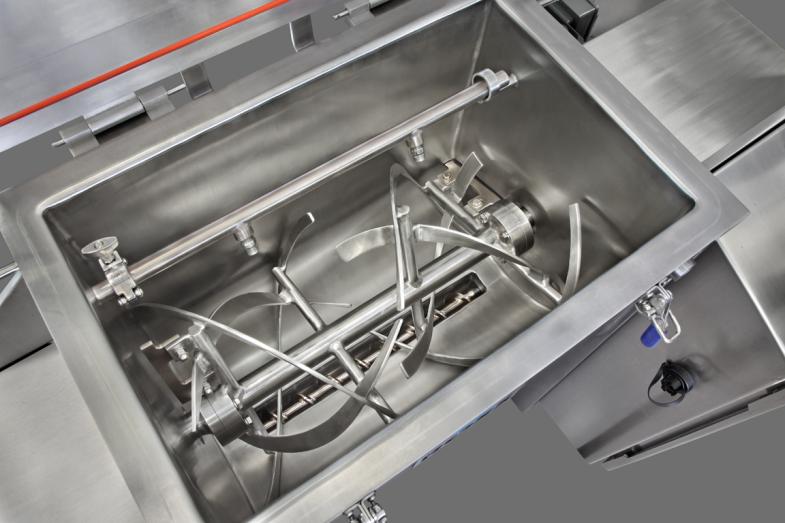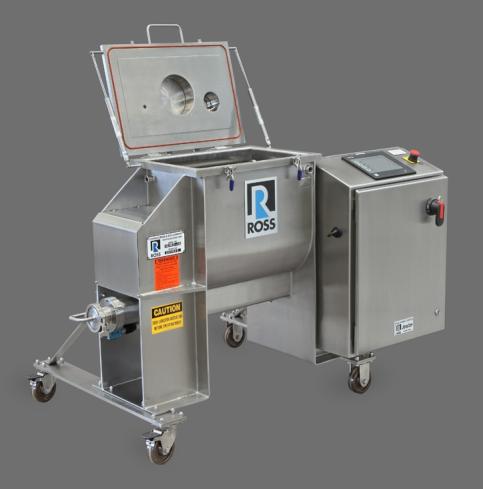Tech Report
Tips for liquid addition in a ribbon blender

Technology Brief
Mixing wet and dry ingredients in a ribbon blender requires an efficient and consistent method of raw material addition. This method depends on several factors including the properties of each liquid and solid component, how they interact, as well as the amount of fluid that needs to be added. This bulletin presents some useful techniques that may apply to your particular process.
Versatile ribbon blender
Ribbon blenders are commonly used for blending dry powders, granules, pellets and other solid forms. The agitator's inner and outer helical ribbons are pitched to move material axially, in opposing directions, and also radially. This combination promotes fast and thorough mixing. Although dry blending is the ribbon blender's primary use, it can also function as a paste mixer, vacuum dryer and granulator/coater (by evenly coating a minor liquid component throughout the surfaces of the solid particles).
The addition of liquids to a dry batch can be accomplished in several ways. Choosing the right method is crucial to establishing repeatable blending results in the shortest cycle time possible.
Some tips to consider
- If the liquid component is a minor ingredient, like a fragrance, coloring or flavoring, introduce it to the dry raw materials through atomizing nozzles installed in a spray bar assembly. A metering pump may be used to feed the liquid at a controlled rate, or the spray bar may be connected to a pressure vessel. The liquid flow rate is critical because you want to avoid flooding the blender, forming wet clumps of powder, or unnecessarily delaying the mixing cycle. Liquids are normally added while the batch is being agitated in order to help ensure uniform coating or absorption. Because different solids behave differently upon contact with liquid, testing is recommended to confirm the proper pressure setting or liquid flow rate, the nozzle size, type and location, blender speed, etc.
- When handling paste-like or slurry applications, liquids may be added through the cover or charge ports. For instance, ribbon blenders used for mixing cake batter typically have dedicated injection ports for water, oil and eggs. Make sure that your discharge valve is liquid-tight, as many blenders come with valves that are only dust-tight.
- Ribbon blenders equipped with an extrusion screw along the bottom of the trough are ideal for mixing thick pastes and other viscous applications. The screw auger enhances mixing and enables 100% complete discharge. A die with multiple holes or slots may even be installed at the outlet so the finished product is discharged in threads or sheets.
- Do not under fill your blender. Optimal mixing in a ribbon blender requires enough batch material - equivalent to at least 30-40% of the rated volumetric capacity. Working with smaller volumes, the blender fails to generate adequate contact between the agitator and the product. In addition, the chances of materials building up on the sidewall or parts of the agitator are higher when liquid is sprayed to an under filled batch. Interior surfaces must be well polished and each weld should be radiused to help prevent material buildup.
- A well-designed blender holds close tolerances - in the range of 1/8" to 3/16"- between the outer ribbon and the trough to prevent "dead zones" in the batch. Installing scrapers in strategic parts of the agitator (set as close as possible to the trough wall without touching) is recommended for wet powder applications that tend to pack in corners.
Sample Application: Veterinary Products

Shown is a Ross Model 42NSD-1S used for sanitary production of veterinary blends. This vacuum rated multi-purpose unit is equipped with interchangeable double ribbon and paddle agitators, spray bar assembly as well as a discharge extruder. The built-in NEMA 4X controls includes a variable frequency drive(VFD) keypad for convenient soft start and speed control of both the main agitator and the screw auger of the discharge extruder.